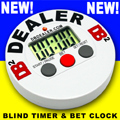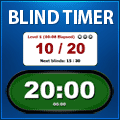|
|
Heads-up Poker TournamentsHere is some information on how to run a heads-up poker tournament. A heads-up poker tournament is a series of one-on-one matches with the winner of the match going on to play in further rounds. Each match should last an hour to an hour-and-a-half in length so that you can play four or five rounds of matches in one night. Heads-up games are much more unpredictable than larger games. A heads-up match might last an hour or a minute! There's lots of raising and bluffing and all-in bets which make the games very exciting. A nice benefit of holding a heads-up tournament is that players who have busted out can easily start up side-matches (for a friendly wager) that can run at the same time as the main tournament. While playing heads-up poker is the main requirement on the path to improving your game, HUSNG.com is the top heads up poker training site. They offer over 800 free and membership instructional videos, articles, tools, blogs, forums and more, all dedicated to taking your heads-up game to the next level. Heads-up Poker Tournament StructuresThere are three basic structures you can use for your heads-up tournament: single-elimination, double-elimination, and round-robin. The simplest tournament structure is a single-elimination format. You are eliminated from the tournament when you lose. Sixteen players are whittled down to 8 players, then 4 players, then 2 players who play in the final match. You can easily use this format with 4, 8, 16, 32 or 64 players but problems arise if you do not have the exact number of players needed. If you have 19 players, you can only let 16 players play unless you offer 'byes' for 3 players. To calculate the number of matches needed for your single-elimination tournament, take the number of players and subtract one. A 16-player tournament will require 15 games to complete. A double-elimination tournament means that you are eliminated from the tournament when you lose for the second time. This ensures that every player gets to play in at least two matches. To calculate the number of matches needed for your double-elimination tournament, multiply the number of players by two and then subtract one. A round-robin tournament means that each player plays numerous matches against different opponents and then players are ranked depending on their won/loss record. The player with the best won-loss record is ranked number one, the player with the second best won-loss record is ranked number two, etc.. The top ranked players then proceed on to a single or double-elimination playoff. The best heads-up tournament format would probably be a round-robin tournament where every player plays every other player at least once. The top 8 or 16 players then play a double-elimination tournament to decide the winner. Poker Tournament DirectorRemember that you will have numerous matches being played at the same time, that all players will deal, and that many of those players have never dealt hold'em before ... and you want to play! Good luck! Number of PlayersBecause of the one-on-one nature of a heads-up tournament, it is much easier to schedule matches if you have a group of 2, 4, 8, 16, or 32 players. Having any other number of players means that you will have to offer 'byes' (free passes) for certain players. If you must decide which player should be allowed a bye into another round you can do it randomly or you can 'auction' off the bye to the highest bidder - the eligible player that is willing to put the most additional money into the purse gets the bye. Heads-up Poker SeatingAssuming that you already own an oval poker table, you can seat 3 or 4 different matches at one table by having the opposing players sit across the table from each other. You might be able to seat 8 players at one large poker table (4 matches) but this will probably be a bit too crowded so plan on seating 6 players (3 matches) at each table. You can set up smaller side-tables if you do not have enough room at your full-size poker tables. Many people own folding-leg card tables and chairs that can easily be brought to your house. Try to seat all players in the same room. Dealer & Poker BlindsIn heads-up play, the dealer is the small blind and acts first before the flop and last after the flop. The first card is dealt to the non-dealer (the big blind). Poker SuppliesYou will need a deck of cards and a dealer button for each match. Make sure to use different colored decks if you playing multiple matches at the same table. Chips NeededIf you begin each match with the initial buyin of poker chips you won't need any more poker chips than what you use for your regular poker tournaments of the same size. if you usually hold 16-player tournaments, you usually issue 16,000 in chips. If you host a heads-up tournament of 16 players, you will still issue the same 16,000 in chips. You don't have to worry about rebuys or add-ons. Keep in mind that you will require many different colored chips, and several color-ups, if you allow players to accumulate chips from one match to the next throughout the tournament. You will probably begin the tournament with T25 chips but the final two players will each have many thousands of chips in play. You will to color-up numerous times (not hard to do between matches) and adjust your blinds accordingly. Each Match Begins With Only the Initial BuyinDo not allow the winners to accumulate chips from one match to the next - make each match begin with the initial buyin. If your initial buyin is 1000 chips - every match throughout the tournament begins with 1000 chips. Using this method you can use the same chips for every match. In effect, you don't even have to issue chips to each individual player - at the beginning of the tournament simply place 1000 chips in front of each seat. Before each match begins, every player is responsible for counting the chips in front of them. After each match, the chips are divided in half for the next match. Most professional heads-up tournaments allow you to accumulate chips as you win games. If you start with 1000 chips per player, you will have 2000 chips after winning one game, 4000 chips after winning two games, 8000 chips after winning three games, etc.. But, if you allow the winners to accumulate chips, you will have to keep coloring-up to higher denomination chips and, most importantly, the blinds will have to increase for each round of play. To avoid having to increase your blinds, and to avoid having to color-up chips, and to avoid having to handle any chips at all during the tournament - start each match with the initial buyin in chips for each player! Seeding Poker PlayersYou can have players randomly pick numbers for their seats or you can use a deck of cards. High card (clubs, diamonds, hearts, spades - highest) is seat one, second highest card is seat two, third highest card is seat 3, etc.. You can also seed players so that the best players play the worst players, hopefully resulting in the two best players eventually reaching the final game. Heads-up Poker BlindsYou want each match to last a little over an hour to an hour-and-a-half. This will allow for four rounds of matches in a single night or 8 or 16 rounds in a full day or weekend. You can issue any number of chips to start your tournament but your guests will probably feel most comfortable if you use the same number of chips as you do for your regular tournaments. Even though you do use the same number of starting chips, the blinds schedule will have to be altered to make each match last about one hour. Blinds should increase every 10 or 15 minutes and every match should start at the same time so that you can use only one timer. Encourage your players to start 'gambling' at the half-hour mark rather than waiting for the blinds to raise so high that it becomes an all-in fest at the end of the match.
The schedule on the left is a T1000 heads-up schedule and could be used with a chip distribution of The schedule on the right is a T10,000 heads-up schedule and could be used with a chip distribution of Both of these schedules are available Heads-up Poker Brackets
Tournament Structures & BracketsThere are numerous tournament formats that could be used for your heads-up poker tournament. If you are going to hold a larger, more official heads-up tournament you should probably not use the simple brackets that I have available on this site. Large brackets should be adjusted so that there is some cross-over between the different brackets. My brackets are fine for up to 16 or 32 players but you should use different brackets if you are going to host a 128-player tournament in your home! If you go to Google and type 'tournament scheduler' or 'free tournament brackets' into the search field you will be presented with numerous options. You can create your brackets and post the results on a web page for free at BracketMaker.com. PayoutPayout the winner, or the final two players, or tiers of players. You don't want to have to determine who finished 3rd and 4th, or who finished 5th, 6th, 7th, and 8th ... they all finished equal so should be paid out equally. Payout a large percentage to the winner, a smaller percentage to 2nd place, and a shared percentage to 3rd and 4th place, a shared percentage to 5th, 6th, 7, and 8th, place, etc.. You can easily payout 60% to the winner, 20% to second place and 20% (10% each) to the third and fourth place finishers. You can also have a consolation match between 3rd and 4th place at the same time as the 1st and 2nd place match is taking place. Players Busting Out (side-games)It is very easy to get one-on-one side-games going. As soon as two players bust out, they can challenge each other to a side game for $5 or whatever amount they feel like wagering. The chips are already set up and they can play at the same time as other matches are taking place. As more players bust out, they can all play round-robin one-on-one side-games. The matches don't have to stop with the final match that determines the tournament winner, sometimes grudge matches can go on all night! Heads-up Poker Tournament Rules
Links
NBC National Heads-up Poker Championship |
||||||||||||||||||||||||||||||||||||||||||||||||||||||
Online Poker Guide
Hand Converter
Holdem strategy
Freeroll tournaments
Poker calculator
Online poker
Poker rooms
> poker pokeren
> iDeal poker
> online casino
> iDeal casino
> casino casinos
> casino bonus
Get Bonus code Titan Poker, and full tilt poker referral code or max bonus to the full tilt referral code. Best ultimate bet referral code sign up bonus doyles room promo code or poker host bonus code
























